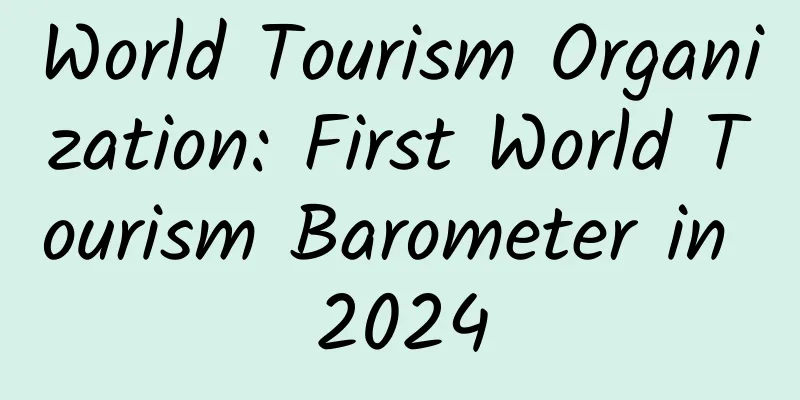World Tourism Organization: First World Tourism Barometer in 2024

|
The World Tourism Organization recently released the first "World Tourism Barometer" for 2024, pointing out that by the end of 2023, the international tourism industry will recover to 88% of the pre-epidemic level, and the number of international tourists is expected to reach 1.3 billion. The tourism demand that has been suppressed for several years, the improvement of air transport connectivity, and the strong recovery of Asian markets and tourist attractions may lay the foundation for the full recovery of the tourism industry by the end of 2024. The Middle East, Europe and Africa saw the strongest tourism performance The World Tourism Barometer provides a comprehensive overview of how the tourism industry will perform in 2023 compared to pre-pandemic conditions in 2019, and tracks recovery by global region, sub-region and destination. The main situations are: The Middle East was relatively ahead in recovery and was the only region to exceed pre-pandemic levels, with arrivals growing 22%. Europe, the region receiving the most tourists worldwide, reached 94% of pre-pandemic levels, driven by high regional demand and support from American tourists. Tourist numbers in Africa have recovered to 96% of pre-pandemic levels, and in the Americas to 90% of pre-pandemic levels. With the reopening of multiple tourism markets and destinations, the Asia-Pacific region has recovered to 65% of pre-pandemic levels. However, the performance of each region is mixed, with South Asia having recovered to 87% and Northeast Asia only about 55%. Available data show that some destinations, including large established destinations as well as smaller emerging destinations, saw double-digit growth in international tourist arrivals in 2023 compared to 2019. Four sub-regions – Southern Mediterranean Europe, the Caribbean, Central America and North Africa – saw arrivals exceed 2019 levels. “The latest UNWTO data highlights the resilience and rapid recovery of the tourism sector, which is expected to reach pre-pandemic levels by the end of 2024,” said UNWTO Secretary-General Zurab Pololikashvili. “The rebound in tourism is already providing a significant boost to economies, jobs and growth around the world, and offering a wealth of opportunities. These figures also remind us that promoting sustainable and inclusive growth in the tourism sector is a critical task.” International tourism reaches $1.4 trillion The latest data from UNWTO also highlights the impact of the tourism industry's recovery on the economy. According to preliminary estimates, international tourism revenue will reach US$1.4 trillion in 2023, which is about 93% of the US$1.5 trillion in tourism revenue in 2019. Total export revenue from tourism (including passenger transport) is expected to be $1.6 trillion in 2023, almost 95% of the $1.7 trillion in 2019. The preliminary estimate of tourism's contribution to the economy in 2023, measured by tourism direct GDP, is $3.3 trillion, or 3% of global GDP. This suggests that tourism direct GDP in 2023 has nearly recovered to pre-pandemic levels, driven by the booming domestic and international tourism. Several destinations reported strong growth in international tourism receipts in the first ten to twelve months of 2023, in some cases outstripping growth in inbound tourist arrivals. Several large source markets also reported strong outbound travel demand during this period, with many exceeding 2019 levels. The continued recovery is also reflected in the performance of industry indicators. According to the UNWTO's Tourism Recovery Tracker, by October 2023, international air capacity and passenger demand will have recovered to around 90% of pre-pandemic levels. In November, the occupancy rate of global accommodation facilities reached 65%, slightly higher than 62% in November 2022. Looking ahead to 2024 In 2024, international tourism is expected to fully recover to pre-pandemic levels, with preliminary estimates showing a 2% increase over 2019. UNWTO made this core forecast because the recovery of tourism in Asia will accelerate and existing economic and geopolitical risks are showing a weakening trend. UNWTO’s latest Tourism Confidence Index survey reflects a bright outlook for the industry, with 67% of tourism professionals saying the outlook for 2024 will be better or much better than in 2023, while about 28% expect the tourism industry to perform similarly in 2024 to 2023. Key considerations include: There is still a lot of room for recovery across Asia. The reopening of some source markets and tourist destinations will drive the recovery of tourism in the region and even globally. China’s outbound and inbound tourism is expected to accelerate in 2024, driven by visa facilitation and increased air capacity. China has implemented a one-year visa-free policy for citizens of France, Germany, Italy, the Netherlands, Spain, and Malaysia until November 30, 2024. Visa and travel facilitation measures will boost travel in and around the Middle East and Africa, with GCC countries implementing a unified tourist visa similar to the Schengen visa, and measures to facilitate intra-African travel in Kenya and Rwanda. Europe is expected to achieve another tourism success in 2024. In March, Romania and Bulgaria will join the Schengen area, and Paris will host the Olympic Games in July and August, which will promote the free movement of people. Strong tourism driven by U.S. tourists, supported by a stronger U.S. dollar, will continue to benefit destinations in the Americas and beyond. As in 2023, strong source markets in Europe, the Americas and the Middle East will continue to drive global tourism and spending. In addition, 6% of respondents still expect that the performance of international tourism this year will be worse than last year. The reasons are: Economic and geopolitical headwinds will continue to pose significant challenges to the continued recovery and confidence levels of the international tourism industry. Persistent inflation, high interest rates, oil price volatility and trade disruptions will continue to impact transportation and accommodation costs in 2024. In this context, it is expected that tourists will increasingly pursue cost-effective tourism projects or choose short trips, giving more consideration to sustainability. Staffing shortages remain a key issue. The tourism industry is facing a labor shortage and is struggling to cope with the surge in demand. The evolution of the Israeli-Palestinian conflict could hamper tourism development in the Middle East and affect tourist confidence. Uncertainty caused by the Russia-Ukraine conflict and other escalating geopolitical situations will also continue to weigh on people's confidence. |
<<: KCI: 2023Q4 Consumer Survey Report
>>: Alibaba: Alimama Business Guide Vol.03
Recommend
What is everything made of? This question led to the most successful scientific theory in history!
If we could divide an apple, or anything around y...
Toxicity of Morinda officinalis
Morinda officinalis is a Chinese herbal medicine,...
In order to achieve "carbon neutrality", the stones on the Qinghai-Tibet Plateau are also working hard
When you think of "absorbing carbon dioxide&...
Benefits of Chinese herbal raspberry
There are various kinds of medicinal materials in...
Good at it but loves to have fun! Is the “cowardly version” of bungee jumping a boon for people with acrophobia?
During the summer vacation, major tourist attract...
How to prevent phishing? Learn more about phishing in one article →
Fish bite because they are greedy, why do you cli...
The efficacy and function of eagle claw
Many people are not very clear about the effects ...
The efficacy and function of tiger-striped snake
Tiger-striped water snake is a very common medici...
The efficacy and function of Hainan eggplant
Hainan eggplant is a common medicinal material in...
Suddenly exposed to be toxic! Something I use every day is actually broken? Doctors give urgent warning →
Many people like to collect ceramic bowls recentl...
The effect of drinking dried Lingzhi in water
We need to replenish the lack of water in the bod...
Was Tyrannosaurus Rex also a picky eater when it was young? New fossils reveal the secret of Tyrannosaurus Rex's "last meal"
Adult Tyrannosaurus rex was a formidable predator...
In the hot summer, come and discover those colorful cicadas
A summer would not be complete without the chirpi...
How to "eat" poisonous mushrooms in the name of science? Psychedelic mushrooms: Thanks for the invitation
"Red umbrella, white pole, let's lie dow...
The efficacy and function of red compress
Hongfudifa is a common Chinese medicine. It can b...









